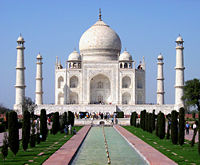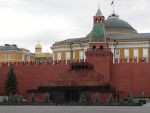Difference between revisions of "Mausoleum" - New World Encyclopedia
Nick Perez (talk | contribs) |
Nick Perez (talk | contribs) |
||
| Line 41: | Line 41: | ||
Of all the mauslea in China, ([[Ancient Tombs at Longtou Mountain]], [[Mausoleum of Princess Zhenxiao]], [[Mausoleum of the First Qin Emperor]], [[Xi'an]], [[Mausoleum of Genghis Khan]], [[Inner Mongolia]], [[Ming Dynasty Tombs|Thirteen Imperial Mausoleums of Ming Dynasty Emperors]], [[Beijing]], [[Ming Xiaoling Mausoleum]], [[Nanjing]], [[Sun Yat-sen Mausoleum]], [[Nanjing]], [[Zhao Mausoleum]], [[Jiuzong mountain]], [[Shaanxi]] province) the most famous perhaps is the [[Mausoleum of Mao Zedong]], [[Beijing]], [[Tiananmen Square]]. | Of all the mauslea in China, ([[Ancient Tombs at Longtou Mountain]], [[Mausoleum of Princess Zhenxiao]], [[Mausoleum of the First Qin Emperor]], [[Xi'an]], [[Mausoleum of Genghis Khan]], [[Inner Mongolia]], [[Ming Dynasty Tombs|Thirteen Imperial Mausoleums of Ming Dynasty Emperors]], [[Beijing]], [[Ming Xiaoling Mausoleum]], [[Nanjing]], [[Sun Yat-sen Mausoleum]], [[Nanjing]], [[Zhao Mausoleum]], [[Jiuzong mountain]], [[Shaanxi]] province) the most famous perhaps is the [[Mausoleum of Mao Zedong]], [[Beijing]], [[Tiananmen Square]]. | ||
| + | The '''Chairman Mao Memorial Hall''' ({{zh-cp|c=毛主席纪念堂|p=Máo Zhǔxí Jìniàntáng}}), commonly known as the '''Mausoleum of Mao Zedong''', or the '''Mao Mausoleum''', is the last resting place of [[Mao Zedong]], Chairman of the [[Politburo of the Communist Party of China|Politburo]] of the [[Communist Party of China]] from [[1943]] and the chairman of the Central Committee of the Communist Party of China from [[1945]] until his death. | ||
| + | Although Mao had wished to be cremated, his body was [[embalmed]], and construction of a mausoleum began shortly after his death. This highly popular attraction is located in the middle of [[Tiananmen Square]], in [[Beijing]], the capital of [[China]]. On this site had previously stood the [[Gate of China, Beijing|Gate of China]], the southern (main) gate of the Imperial City during the [[Ming Dynasty|Ming]] and [[Qing Dynasty|Qing]] dynasties. | ||
| − | + | The remains of the ''Great Helmsman'', as he is sometimes known, are on display for public viewing. People queue up for hundreds of metres every day to see the former chairman, many paying tribute to him with flowers that can be rented at the entrance on the north side. There is a souvenir shop at the exit on the south side. | |
| − | |||
| − | |||
==[[Finland]]== | ==[[Finland]]== | ||
[[Image:Juselius_mausoleum.jpg|thumb|right|150px|The [[Juselius Mausoleum]] lies in [[Pori]], [[Finland]]]] | [[Image:Juselius_mausoleum.jpg|thumb|right|150px|The [[Juselius Mausoleum]] lies in [[Pori]], [[Finland]]]] | ||
| − | The [[Juselius Mausoleum]], in the city of [[Pori]]. | + | The [[Juselius Mausoleum]], in the city of [[Pori]].The [[Neo-Gothic]] [[Juselius Mausoleum]], located in the Käppärä cemetery in central Pori, was built in [[1903]] by the wealthy industrialist F.A. Juselius for his daughter Sigrid who died when she was only 11 years old. The Mausoleum was designed by the [[architect]] [[Josef Stenbäck]]. The Mausoleum originally had frescoes painted by artist [[Akseli Gallen-Kallela]], but these decayed after a short time. The frescoes were restored by Akseli's son [[Jorma Gallen-Kallela]] using his father's sketches. |
==[[India]]== | ==[[India]]== | ||
[[Image:Taj Mahal in March 2004.jpg|thumb|left|200 px|Taj Mahal]] | [[Image:Taj Mahal in March 2004.jpg|thumb|left|200 px|Taj Mahal]] | ||
| − | The | + | The Tāj Mahal is a mausoleum located in Agra, India. The Mughal emperor Shāh Jahān commissioned it as the final resting place for his favorite wife, Mumtaz Mahal. Construction began in 1632 and was completed in 1648. |
| + | The Taj Mahal is considered by many to be the finest example of Mughal architecture, a style that combines elements of Persian and Indian styles. Some dispute surrounds the question of who designed the Taj. A team of designers and craftsmen were responsible for the design, with the Persian architect Ustad Isa usually considered the most likely candidate as the principal designer. While the white domed marble mausoleum is the most familiar part of the monument, the Taj Mahal is actually an integrated complex of structures. | ||
| + | Shah Jahan intended the Taj Mahal to be acclaimed by the entire world, and since its construction the building has been the source of an admiration that has transcended cultures and geography. Personal and emotional responses to the building have consistently eclipsed the scholastic appraisals of the monument. The poet Rabindranath Tagore, a Nobel laureate, called Taj Mahal "a drop of tear on the cheek of history." | ||
== [[Iran]] == | == [[Iran]] == | ||
[[Iran's Cultural Heritage Organization]] lists several hundred mausoleums in Iran. ''(See [[Ferdowsi]] and [[Ziyarat]] articles for some examples)''. Many such as [[Ali ar-Rida|Imam Reza Mausoleum]] in [[Mashhad]] are religious and from bygone eras. Some, such as the mausoleum of [[Cyrus the great]] carry national significance, and others, such as the [[Imam Khomeini mausoleum]] in [[Tehran]] are contemporary and carry more political weight. | [[Iran's Cultural Heritage Organization]] lists several hundred mausoleums in Iran. ''(See [[Ferdowsi]] and [[Ziyarat]] articles for some examples)''. Many such as [[Ali ar-Rida|Imam Reza Mausoleum]] in [[Mashhad]] are religious and from bygone eras. Some, such as the mausoleum of [[Cyrus the great]] carry national significance, and others, such as the [[Imam Khomeini mausoleum]] in [[Tehran]] are contemporary and carry more political weight. | ||
| − | [[Image:AbdolSamad Natanz.jpg|thumb|left|150px|Tomb of [[Abdol-samad]], built in 1304C.E. in [[Natanz]].]] | + | [[Image:AbdolSamad Natanz.jpg|thumb|left|150px|Tomb of [[Abdol-samad]], built in 1304C.E. in [[Natanz]].]][[Image:AbdolSamad Natanz.jpg|right|thumb|Tomb of Abdol-samad, built in 1304C.E.]]'''Sheikh Abd al-Samad Esfahani''' (شیخ عبد الصمد اصفهانی) was a famous [[Ilkhanid]] era [[Sufi]] of the 13th century. |
| − | |||
| − | |||
| − | [[Image: | ||
| − | [[ | ||
| + | After his death, a shrine was built in [[Natanz]] to honor the Sheikh by the Sheikh's disciple, the [[Ilkhanid]] [[vizier]] ''Zain al-Din Mastari''. | ||
| + | He reportedly died in 1299C.E. in [[Natanz]]. | ||
| + | ==[[Israel]]== | ||
| + | [[Image:Avtomb.JPG|thumb|right|150px|[[Yad Avshalom]], Jerusaelm]]]] | ||
| + | The 'tomb' known today as '''Yad Avshalom''' (Avshalom's Monument - יד אבשלום) is located in the [[Kidron Valley]] in [[Jerusalem]], situated between the [[Temple Mount]] and [[Mount of Olives]]. | ||
| + | Archaeologists have dated the 'tomb' to the first century CE. It is believed to be the 'tomb' of [[Absalom]]. It may contradict 2 Samuel 18:17 which says Absalom's body was covered over with stones in a pit in the forest of Ephraim. | ||
| + | The Jewish tradition connects it to [[Absalom]] son of King [[David]]. According to 2 Samuel 18:18, | ||
| + | "''Absalom in his lifetime had taken and reared up for himself a pillar, which is in the king's dale: for he said, I have no son to keep my name in remembrance: and he called the Monument after his own name: and it is called unto this day, Absalom's Monument''. | ||
| + | The people of Jerusalem, for centuries, used to come to this monument with their children and stone it - to show children what happens to sons who disobey their parents. | ||
| + | According to a local legend, [[Napoleon]] fired a mortar at the tomb and removed the shape of a hand that topped the conical roof. The legend continues that he was angry at Absalom for rebelling against his father, [[David]]. It is known however that Napoleon never reached Jerusalem during his campaign in the Holy Land. | ||
| + | A Muslim tradition connects it to the Pharaohs - hence the Arabic name "Pharaoh's Hat". | ||
==[[Pakistan]]== | ==[[Pakistan]]== | ||
Revision as of 19:05, 10 September 2007
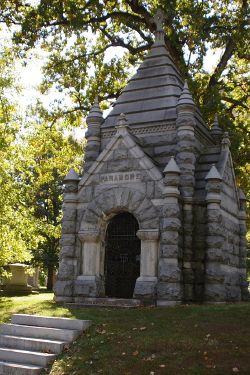
A mausoleum (plural: mausolea) is an external free-standing building constructed as a monument enclosing the interment space or burial chamber of a deceased person or persons. A mausoleum may be considered a type of tomb or the tomb may be considered to be within the mausoleum. A Christian mausoleum sometimes includes a chapel.
Etymology
The word derives from the Mausoleum of Maussollos (near modern-day Bodrum in Turkey), the grave of King Mausollos, the Persian satrap of Caria, whose large tomb was one of the Seven Wonders of the Ancient World.
Description
Origin
Historically, mausolea were, and still may be, large and impressive constructions for a deceased leader or other person of importance. However, smaller mausolea soon became popular with the gentry and nobility in many countries, particularly in Europe and her colonies during the early modern and modern periods. These are usually small buildings with walls, a roof and sometimes a door for additional interments or visitor access. Single mausolea may be permanently sealed. A mausoleum encloses a burial chamber either wholly above ground or within a burial vault below the superstructure. This contains the body or bodies, probably within sarcophagi or interment niches. Modern mausolea may also act as columbaria (a type of mausoleum for cremated remains) with additional cinerary urn niches. Mausolea may be located in a cemetery, a churchyard or on private land.
Notable mausolea
- Grant's Tomb, New York City - a reduced-scale version of Mausollos' original mausoleum.
- Taj Mahal at Agra, India
- Mazar-e-Quaid at Karachi, Pakistan
- Royal Mausoleum and the Duchess of Kent's Mausoleum at Frogmore, England
- Hamilton Mausoleum at Hamilton in Scotland
- Abraham Lincoln's tomb in Springfield, Illinois
- Lenin's Mausoleum in Moscow, Russia.
- The Mastaba
- The pyramids of ancient Egypt, Nubia and China are also types of mausolea.
- For cemeteries containing multiple notable mausolea, see also List of famous cemeteries.
This is a list of mausolea around the world.
Nizami Mausoleum
The Nezami Mausoleum, built in 1991 in honor of Nezāmī Ganjavī, stands just outside the city of Ganja, Azerbaijan. It is a tall cylindrical building, surrounded by gardens. To one side, there is a metal statue commemorating Nezami's epic poems.
China

Of all the mauslea in China, (Ancient Tombs at Longtou Mountain, Mausoleum of Princess Zhenxiao, Mausoleum of the First Qin Emperor, Xi'an, Mausoleum of Genghis Khan, Inner Mongolia, Thirteen Imperial Mausoleums of Ming Dynasty Emperors, Beijing, Ming Xiaoling Mausoleum, Nanjing, Sun Yat-sen Mausoleum, Nanjing, Zhao Mausoleum, Jiuzong mountain, Shaanxi province) the most famous perhaps is the Mausoleum of Mao Zedong, Beijing, Tiananmen Square.
The Chairman Mao Memorial Hall (Chinese: 毛主席纪念堂; pinyin: Máo Zhǔxí Jìniàntáng), commonly known as the Mausoleum of Mao Zedong, or the Mao Mausoleum, is the last resting place of Mao Zedong, Chairman of the Politburo of the Communist Party of China from 1943 and the chairman of the Central Committee of the Communist Party of China from 1945 until his death.
Although Mao had wished to be cremated, his body was embalmed, and construction of a mausoleum began shortly after his death. This highly popular attraction is located in the middle of Tiananmen Square, in Beijing, the capital of China. On this site had previously stood the Gate of China, the southern (main) gate of the Imperial City during the Ming and Qing dynasties.
The remains of the Great Helmsman, as he is sometimes known, are on display for public viewing. People queue up for hundreds of metres every day to see the former chairman, many paying tribute to him with flowers that can be rented at the entrance on the north side. There is a souvenir shop at the exit on the south side.
Finland
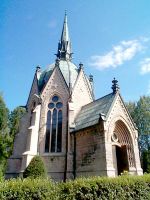
The Juselius Mausoleum, in the city of Pori.The Neo-Gothic Juselius Mausoleum, located in the Käppärä cemetery in central Pori, was built in 1903 by the wealthy industrialist F.A. Juselius for his daughter Sigrid who died when she was only 11 years old. The Mausoleum was designed by the architect Josef Stenbäck. The Mausoleum originally had frescoes painted by artist Akseli Gallen-Kallela, but these decayed after a short time. The frescoes were restored by Akseli's son Jorma Gallen-Kallela using his father's sketches.
India
The Tāj Mahal is a mausoleum located in Agra, India. The Mughal emperor Shāh Jahān commissioned it as the final resting place for his favorite wife, Mumtaz Mahal. Construction began in 1632 and was completed in 1648.
The Taj Mahal is considered by many to be the finest example of Mughal architecture, a style that combines elements of Persian and Indian styles. Some dispute surrounds the question of who designed the Taj. A team of designers and craftsmen were responsible for the design, with the Persian architect Ustad Isa usually considered the most likely candidate as the principal designer. While the white domed marble mausoleum is the most familiar part of the monument, the Taj Mahal is actually an integrated complex of structures.
Shah Jahan intended the Taj Mahal to be acclaimed by the entire world, and since its construction the building has been the source of an admiration that has transcended cultures and geography. Personal and emotional responses to the building have consistently eclipsed the scholastic appraisals of the monument. The poet Rabindranath Tagore, a Nobel laureate, called Taj Mahal "a drop of tear on the cheek of history."
Iran
Iran's Cultural Heritage Organization lists several hundred mausoleums in Iran. (See Ferdowsi and Ziyarat articles for some examples). Many such as Imam Reza Mausoleum in Mashhad are religious and from bygone eras. Some, such as the mausoleum of Cyrus the great carry national significance, and others, such as the Imam Khomeini mausoleum in Tehran are contemporary and carry more political weight.
Sheikh Abd al-Samad Esfahani (شیخ عبد الصمد اصفهانی) was a famous Ilkhanid era Sufi of the 13th century.
After his death, a shrine was built in Natanz to honor the Sheikh by the Sheikh's disciple, the Ilkhanid vizier Zain al-Din Mastari.
He reportedly died in 1299C.E. in Natanz.
Israel
]]
The 'tomb' known today as Yad Avshalom (Avshalom's Monument - יד אבשלום) is located in the Kidron Valley in Jerusalem, situated between the Temple Mount and Mount of Olives.
Archaeologists have dated the 'tomb' to the first century CE. It is believed to be the 'tomb' of Absalom. It may contradict 2 Samuel 18:17 which says Absalom's body was covered over with stones in a pit in the forest of Ephraim.
The Jewish tradition connects it to Absalom son of King David. According to 2 Samuel 18:18, "Absalom in his lifetime had taken and reared up for himself a pillar, which is in the king's dale: for he said, I have no son to keep my name in remembrance: and he called the Monument after his own name: and it is called unto this day, Absalom's Monument.
The people of Jerusalem, for centuries, used to come to this monument with their children and stone it - to show children what happens to sons who disobey their parents.
According to a local legend, Napoleon fired a mortar at the tomb and removed the shape of a hand that topped the conical roof. The legend continues that he was angry at Absalom for rebelling against his father, David. It is known however that Napoleon never reached Jerusalem during his campaign in the Holy Land.
A Muslim tradition connects it to the Pharaohs - hence the Arabic name "Pharaoh's Hat".
Pakistan
National Mausoleum of Pakistan (Mausoleum of the founder of Pakistan- Muhammad Ali Jinnah), Karachi City
Russia
Spain
- Valle de los Caídos, in San Lorenzo del Escorial.
Turkey
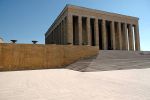
Kemal Atatürk's Mausoleum, Ankara, Turkey
Uzbekistan
Samanid mausoleum Bukhara.
Vietnam
Ho Chi Minh's Mausoleum, Hanoi.
External links
Credits
New World Encyclopedia writers and editors rewrote and completed the Wikipedia article in accordance with New World Encyclopedia standards. This article abides by terms of the Creative Commons CC-by-sa 3.0 License (CC-by-sa), which may be used and disseminated with proper attribution. Credit is due under the terms of this license that can reference both the New World Encyclopedia contributors and the selfless volunteer contributors of the Wikimedia Foundation. To cite this article click here for a list of acceptable citing formats.The history of earlier contributions by wikipedians is accessible to researchers here:
The history of this article since it was imported to New World Encyclopedia:
Note: Some restrictions may apply to use of individual images which are separately licensed.
